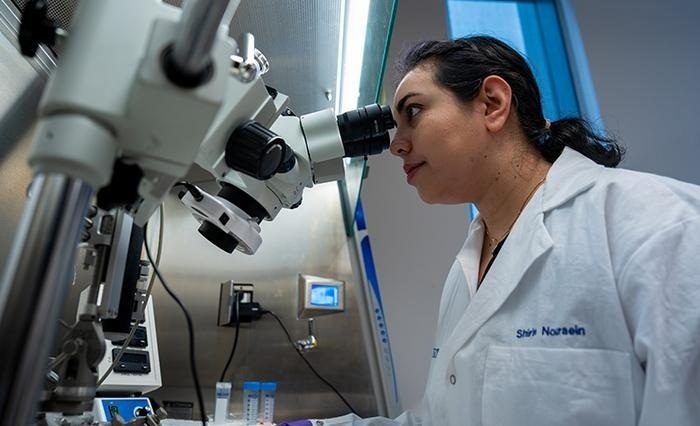Cheap, Paper-Based Testing Platform Could Transform Diagnostics
|
By LabMedica International staff writers Posted on 16 Oct 2024 |

At-home diagnostic tests, such as pregnancy or COVID tests, utilize paper-based assay technology to identify the presence of target molecules. Although these tests are simple and inexpensive, they primarily provide qualitative results, indicating whether a biomarker is present. In contrast, field-effect transistors (FETs), which were initially created for electronic devices, are capable of detecting the concentrations of biological molecules. Today, they serve as highly sensitive biosensors for real-time biomarker detection. Many experts believe that FETs represent the future of biosensing; however, their commercialization has been limited due to the specific testing conditions required. In a highly complex matrix like blood, FETs often struggle to detect signals from analytes. Researchers have now developed a new diagnostic test system that merges an FET with a cost-effective, paper-based diagnostic test. When paired with machine learning, this system evolves into a novel biosensor that could potentially revolutionize at-home testing and diagnostics.
Developed jointly by researchers at the University of Chicago Pritzker School of Molecular Engineering (PME, Chicago, Il, USA) and UCLA Samueli School of Engineering (Los Angeles, CA, USA), the new kind of testing system integrates an FET with a paper-based analytical cartridge, similar to the technology used in at-home pregnancy and COVID tests. This combination harnesses the high sensitivity of FETs along with the low-cost benefits of paper-based cartridges. The paper fluidic technology, particularly its porous sensing membrane, reduces the need for the complicated, controlled testing environments that FETs typically require. Additionally, it offers a low-cost basis for the system, as each cartridge costs approximately 15 cents.
The integration of deep-learning kinetic analysis further enhances the accuracy and precision of the testing results within the FET. To evaluate the system, the researchers programmed the device to measure cholesterol levels from anonymized, leftover human plasma samples. The study results published in ACS Nano indicate that across 30 blind tests, the system measured cholesterol levels with over 97% accuracy—well above the total allowable error of 10% stipulated by CLIA guidelines. The team also conducted a proof-of-concept experiment demonstrating that the device could accommodate immunoassays, which are widely used to quantify hormones, tumor markers, and cardiac biomarkers. The next steps involve developing the system for immunoassay testing, with the ultimate goal of showcasing its ability to detect multiple biomarkers from a single sample input.
“By addressing the limitations in each component and adding in machine learning, we have created a new testing platform that could diagnose disease, detect biomarkers, and monitor therapies at home,” said Hyun-June Jang, a postdoctoral fellow and co-lead author on the paper. “This technology has the potential to detect multiple biomarkers from a single drop of blood.”
Latest Technology News
- AI Saliva Sensor Enables Early Detection of Head and Neck Cancer
- AI-Powered Biosensor Technology to Enable Breath Test for Lung Cancer Detection
- AI Model Achieves Breakthrough Accuracy in Ovarian Cancer Detection
- Portable Biosensor Diagnoses Psychiatric Disorders Using Saliva Samples
- Cell-Sorting Device Uses Electromagnetic Levitation to Precisely Direct Cell Movement

- Embedded GPU Platform Enables Rapid Blood Profiling for POC Diagnostics
- Viral Biosensor Test Simultaneously Detects Hepatitis and HIV
- Acoustofluidic Device to Transform Point-Of-Care sEV-Based Diagnostics
- AI Algorithm Assesses Progressive Decline in Kidney Function
Channels
Clinical Chemistry
view channel
Chemical Imaging Probe Could Track and Treat Prostate Cancer
Prostate cancer remains a leading cause of illness and death among men, with many patients eventually developing resistance to standard hormone-blocking therapies. These drugs often lose effectiveness... Read more
Mismatch Between Two Common Kidney Function Tests Indicates Serious Health Problems
Creatinine has long been the standard for measuring kidney filtration, while cystatin C — a protein produced by all human cells — has been recommended as a complementary marker because it is influenced... Read moreMolecular Diagnostics
view channel
New Serum Marker-Editing Strategy to Improve Diagnosis of Neurological Diseases
Tracking gene-expression changes in the brain is crucial for understanding neurological diseases, yet current monitoring tools are invasive or unable to capture subtle activity shifts over time.... Read more
World’s First Genetic Type 1 Diabetes Risk Test Enables Early Detection
Type 1 Diabetes (T1D) affects more than eight million people worldwide, with numbers expected to rise sharply. While most cases are genetically driven, only one in ten patients has a family history, making... Read moreHematology
view channel
Platelet Activity Blood Test in Middle Age Could Identify Early Alzheimer’s Risk
Early detection of Alzheimer’s disease remains one of the biggest unmet needs in neurology, particularly because the biological changes underlying the disorder begin decades before memory symptoms appear.... Read more
Microvesicles Measurement Could Detect Vascular Injury in Sickle Cell Disease Patients
Assessing disease severity in sickle cell disease (SCD) remains challenging, especially when trying to predict hemolysis, vascular injury, and risk of complications such as vaso-occlusive crises.... Read more
ADLM’s New Coagulation Testing Guidance to Improve Care for Patients on Blood Thinners
Direct oral anticoagulants (DOACs) are one of the most common types of blood thinners. Patients take them to prevent a host of complications that could arise from blood clotting, including stroke, deep... Read moreImmunology
view channel
Gene Signature Test Predicts Response to Key Breast Cancer Treatment
DK4/6 inhibitors paired with hormone therapy have become a cornerstone treatment for advanced HR+/HER2– breast cancer, slowing tumor growth by blocking key proteins that drive cell division.... Read more
Chip Captures Cancer Cells from Blood to Help Select Right Breast Cancer Treatment
Ductal carcinoma in situ (DCIS) accounts for about a quarter of all breast cancer cases and generally carries a good prognosis. This non-invasive form of the disease may or may not become life-threatening.... Read moreMicrobiology
view channelRapid POC Tuberculosis Test Provides Results Within 15 Minutes
Tuberculosis remains one of the world’s deadliest infectious diseases, and reducing new cases depends on identifying individuals with latent infection before it progresses. Current diagnostic tools often... Read more
Rapid Assay Identifies Bloodstream Infection Pathogens Directly from Patient Samples
Bloodstream infections in sepsis progress quickly and demand rapid, precise diagnosis. Current blood-culture methods often take one to five days to identify the pathogen, leaving clinicians to treat blindly... Read morePathology
view channelAI Tool Outperforms Doctors in Spotting Blood Cell Abnormalities
Diagnosing blood disorders depends on recognizing subtle abnormalities in cell size, shape, and structure, yet this process is slow, subjective, and requires years of expert training. Even specialists... Read more
AI Tool Rapidly Analyzes Complex Cancer Images for Personalized Treatment
Complex digital biopsy images that typically take an expert pathologist up to 20 minutes to assess can now be analyzed in about one minute using a new artificial intelligence (AI) tool. The technology... Read moreIndustry
view channel
Abbott Acquires Cancer-Screening Company Exact Sciences
Abbott (Abbott Park, IL, USA) has entered into a definitive agreement to acquire Exact Sciences (Madison, WI, USA), enabling it to enter and lead in fast-growing cancer diagnostics segments.... Read more








 (3) (1).png)















